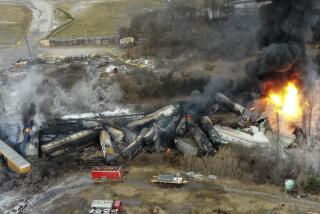U.S. Plans to Rate the Rollover Risk of Vehicles
- Share via
WASHINGTON — The Transportation Department, responding to safety concerns about popular sport-utility vehicles, today will propose a controversial rating system to let consumers compare the risk of rolling over in SUVs, cars, pickups and vans.
The ratings may undermine the mystique of SUVs as fortresses of the modern roadway, since accident statistics show them more likely than other vehicles to tip over. Ratings will be available for some models as early as this fall, officials said.
For the record:
12:00 a.m. May 29, 2000 For the Record
Los Angeles Times Monday May 29, 2000 Home Edition Part A Part A Page 3 Metro Desk 2 inches; 49 words Type of Material: Correction
Vehicle rollovers--A graphic accompanying a story Thursday on the rollover risk of sport utility vehicles misstated the formula the federal government will use to assess rollover potential. The correct stability formula is half the distance between wheels on the same axle, divided by the height of the vehicle’s center of gravity above the road.
Vehicles will be assigned one to five stars (one star being the least safe) based on a mathematical formula that uses height and wheel-to-wheel width to predict stability. The auto industry, however, strongly objects to a math-based rating, saying that it is not a good predictor of either accidents or fatalities.
The National Highway Traffic Safety Administration, which will oversee the new ratings, said that SUVs are likely to receive one to three stars under the new rating system, compared with four to five stars for cars. Pickups are expected to range from one to four stars, and vans from two to three.
A vehicle assigned one star would have a rollover risk of greater than 40% in a sideways skid, an agency official said. Five stars would represent a risk of less than 10%.
Sales of SUVs have exploded in the last 15 years, from 5% of new vehicles in 1985 to 19% last year. Warnings about their tendency to roll over have done little to dent their appeal to consumers, many of whom like the feeling of riding high above traffic.
Rollovers are particularly violent and deadly accidents, killing about 9,500 people a year, 80% of whom are unbelted. Experts say that a recurring pattern involves drivers who take a curve too quickly. The vehicle starts to slide sideways. If the wheels hit a curb or soft shoulder, the whole vehicle can easily tip over.
In 1998, 62% of drivers and passengers killed in sport-utility vehicles died in rollovers. That statistic stands in stark contrast to 22% of fatalities in cars that are attributable to rollovers.
Consumer and insurance industry groups said that the new rollover ratings represent a modest but incomplete effort to improve safety.
“It’s a long-overdue first step,” said Brian O’Neill, president of the nonprofit Insurance Institute for Highway Safety. “Some people are buying SUVs because they believe they are inherently safer. They aren’t because of their rollover propensity.”
But O’Neill said that the government should also set a design standard that would require the auto industry to build SUVs less prone to roll over. The insurance group has been petitioning the traffic safety agency for such a standard since the 1970s.
For its part, the auto industry argues that the government’s rating system is flawed because it is based on a mathematical formula and not test drives or crash performance.
Car makers also say that the ratings will not take into account emerging technologies that have the potential to prevent some rollovers by automatically applying the brakes to one or more wheels when a vehicle starts to slide. Mercedes-Benz and BMW are the only manufacturers that now offer such systems.
“We consider these ratings to be too crude,” said Scott Schmidt, a mechanical engineer and regulatory expert with the Alliance of Automobile Manufacturers. “What we would like to see is for NHTSA to take a little longer and evaluate these new technologies. The industry recommends that NHTSA not go forward at this time.”
An official at the safety agency said, however, that further delays are unlikely and that the rating system would go into effect after a 60-day comment period. The agency has been criticized by consumer groups for moving too slowly on SUV safety. The official said that adjustments to the ratings would be made if the industry’s new anti-rollover systems are proved effective.
The safety agency already rates vehicles according to the level of protection they provide people in front and side impacts, and car makers are quick to trumpet a prized five-star rating in their advertisements. These front and side ratings are determined by crashing vehicles carrying test dummies.
In the 1980s, the safety agency turned down a petition to rate rollover risk through a mathematical formula similar to the one it will announce today. The agency conducted extensive driver tests of SUVs to try to pinpoint the mechanics of how and why they might tip.
But the agency ultimately became convinced that height and width is the best predictor. “At that time, the engineers thought there could be another element,” said an agency official. “But our research since then has found that there really isn’t anything better out there in terms of providing an estimate of the risk.”
With the Clinton administration drawing to a close, the rating system could be the last official action on SUV safety for some time.
“This is it for a while--that’s for sure,” said O’Neill, of the insurance institute. “A new administration is coming in, and it may have different priorities.”
(BEGIN TEXT OF INFOBOX / INFOGRAPHIC)
Top-Heavy Trend
More than 60% of the fatalities in sport-utility vehicle crashes in 1998 were due to rollovers.
ROLL POTENTIAL
A test to rate rollover potential would take the wheel-to-wheel width of a vehicle and multiply it by the height of its center of gravity. For example, a high-riding truck on a narrow width would score poorly.
Here’s how the percentage compares with that of other vehicles:
Data for 1998
SUVs (2,701 fatalities): 62.27%
PICKUPS (5,900): 43.47%
VANS (2,033): 40.63%
CARS (21,116): 22.12%
Source: National Highway Traffic Safety Administration






